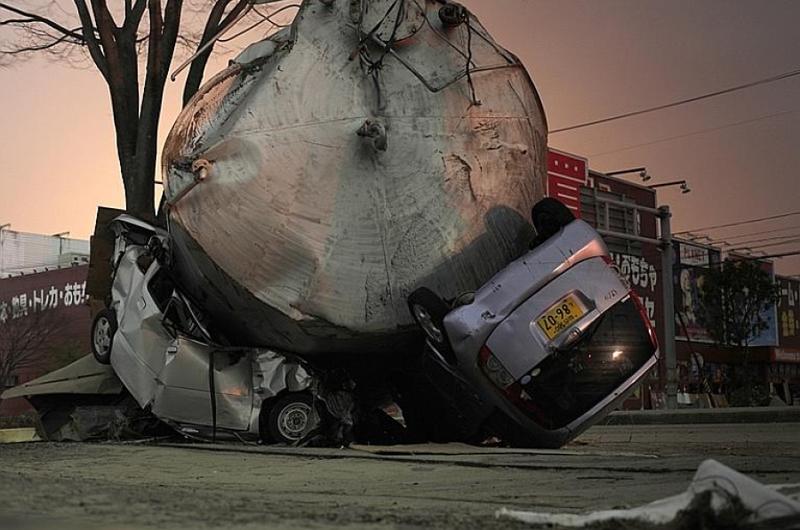

This website was created and maintained from May 2020 to May 2021 to commemorate the 75th anniversary of Stars and Stripes operations in the Pacific.
It will no longer be updated, but we encourage you to explore the site and view content we felt best illustrated Stars and Stripes' continued support of the Pacific theater since 1945.
In Japan's battered north, survivors face cruel uncertainty

The streets of Tagajo, just east of Sendai, are riddled with debris and the battered remains of cars and trucks left behind by the March 2011 earthquake.
By Charlie Reed and Elena Sugiyama | Stars and Stripes March 14, 2011
TAGAJO, Japan — Negotiating her way through the muddy, debris-covered streets here Monday night, where crushed cars and overturned semi trucks laid atop one another, Midori Honda was struggling to survive.
Six months pregnant and alone, she had walked two hours to this small town east of Sendai from a nearby evacuation center, where she has been living since Saturday. She searched through the rubble as the temperatures dropped, hoping to find the car she abandoned three days earlier and retrieve her identification.
The 27-year-old was in Tagajo on Friday when the tsunami hit this coastal area in northern Japan following the massive earthquake. She spent that night on the fifth floor of a parking garage with others who were able to reach higher ground before the unforgiving water swallowed the area, killing thousands in its path.
Amid the sounds of screams, sirens and snapping power lines, Honda said she watched dumbfounded as the water moved in.
It first looked like a wall of debris barreling toward her before the white foamy waves registered as the tsunami.
The water — which topped the third floor of the structure at its peak — receded to knee-level by Saturday, allowing her and the others to escape the area.
“We didn’t know where to go,” said Honda, who eventually found shelter by word of mouth while walking.
Honda, who is from Fukushima about 60 miles to the southwest, has not been able to reach her fiancé or parents since Friday.
“Nobody knows where I am,” said Honda, who has been living on sporadic offerings of bread and rice balls at the evacuation center.
Asked how she was coping with such perils, Honda calmly answered: “I’m tough.”
“I’m just glad I’m alive,” she said as emergency vehicles whizzed up and down the street where she was searching for her car.
The din of helicopters and dust filled the dark sky, illuminated only by the glow of a towering fire at a nearby refinery and the lights of passing vehicles.
Getting the first look at his Tagajo restaurant earlier that day, Shuichi Otomo stood in front of the ramshackle building at sunset, seemingly lost.
He said his family was safe at their home just west of the devastation but that several of his friends were killed in the tsunami.
Rebuilding is “impossible,” said Otomo, 40.
While he and Honda struggled to get their bearings, others in the area began contemplating how they were going to recover.
Though his restaurant was gutted by the water, Yasuyuki Chiba was smiling and already making plans to re-open shop at another location.
As his wife and 9-year-old son salvaged all they could from the building, Chiba siphoned gas from a friend’s government vehicle.
“Please don’t take pictures,” hesaid. “My friend is helping me out.”
Despite his father’s smiles and upbeat attitude, Manato Chiba said he was saddened to see his parents’ life’s work destroyed.
“They worked so hard to get here and now it’s ruined,” he said.


